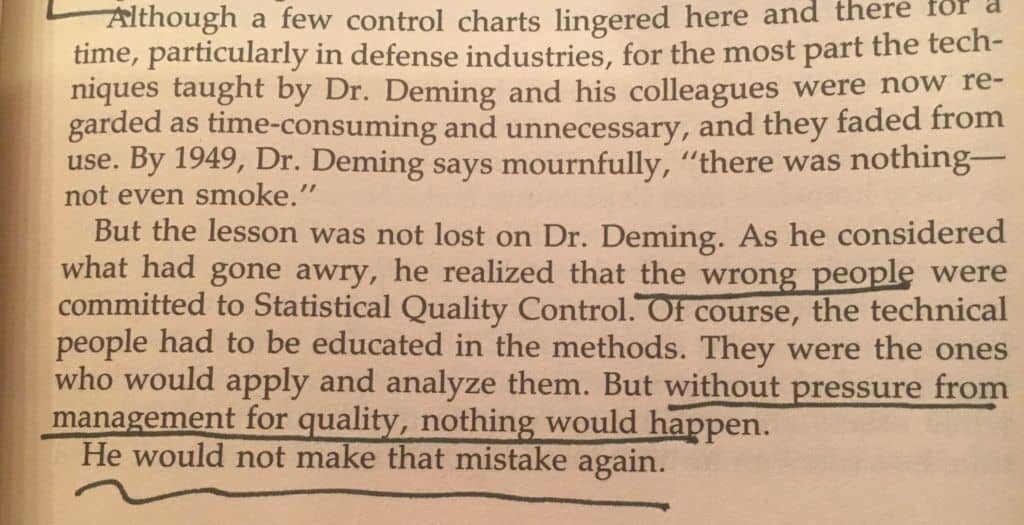One book about the late, great W. Edwards Deming that's been on my shelf for a while is The Deming Management Method, which was written by Mary Walton, a journalist who spent some time with Dr. Deming in the 1980s. I've finally picked the book up to read (what good is a book if you don't read it?).
Before I get to the “mistake” that Dr. Deming talked about, let me take a quick “red bead” detour…
 The book has a chapter that pretty vividly captures Dr. Deming's facilitation of his famed “Red Bead Experiment” (something I'll be doing a pale imitation of at Lean Startup Week, as I blogged about here).
The book has a chapter that pretty vividly captures Dr. Deming's facilitation of his famed “Red Bead Experiment” (something I'll be doing a pale imitation of at Lean Startup Week, as I blogged about here).
One thing I hadn't thought of is Dr. Deming's discussion of the long-term expected value of the number of red beads that would be drawn each time. If there are 20% red beads in the container and 50 holes in the paddle, everybody guesses the long-term average would be 10 red beads.
 Hardly anybody ever draws exactly 10, of course. I'd have to go calculate the longer-term average for my kit over time, as I always capture the data, as shown at left from last week in Austin. Dr. Deming had different paddles with long-term averages of 11.3, 9.6, and 9.4 red beads per draw. Variation in the paddles creates different systems that give different results.
Hardly anybody ever draws exactly 10, of course. I'd have to go calculate the longer-term average for my kit over time, as I always capture the data, as shown at left from last week in Austin. Dr. Deming had different paddles with long-term averages of 11.3, 9.6, and 9.4 red beads per draw. Variation in the paddles creates different systems that give different results.
Dr. Deming says there are a number of reasons why you don't get, on average, 10 beads per draw. In Dr. Deming's kit, he says the red beads are heavier than the white. He says none of the beads are exactly the same size, which is technically correct because of the inherent variation that is in the beads, even if it's miniscule.
So, I took my red bead kit into the kitchen and grabbed my trusty digital kitchen scale. I kept adding white beads to a small bowl on the scale until it reached 10 grams. It took 92 white beads. I learned it took 136 red beads to reach 10 grams. The red beads in my kit are indeed LIGHTER than the white. I'm not sure what I'll do with that information, but now I know.
Dr. Deming, through Walton, summarized the lessons of the Red Bead Experiment as:
- Variation is part of any process
- Planning requires prediction of how things and people will perform. Tests and experiments of past performance can be useful, but not definitive.
- Workers work within a system that – try as they might – is beyond their control. It is the system, not their individual skills, that determines how they perform.
- Only management can change the system.
- Some workers will always be average, some below.
As Dr. Deming said, “You will be seeing red beads wherever you go.”
Dr. Deming's Mistake
Earlier in the book, author Walton writes about Dr. Deming's early life and professional path.
There's a section that really made me think about Lean over the past few decades (and it might seem familiar to those who use Six Sigma or other methods).
Below is a photo of that section…
Dr. Deming talked about the use of Statistical Quality Control methods, namely control charts. After time, a “few control charts lingered here and there.” The methods that Deming and others taught “faded from use” for a number of reasons – they were labeled as “time-consuming and unnecessary” (which might have been more of an excuse than real reality)…
“There was nothing [left] — not even smoke”

Deming later realized (“studying” in a long-term Plan-Do-Study-Adjust cycle) that “the wrong people were committed” to these methods.
Yes, they had to train technical people — are these today's equivalents of “Lean facilitators” and Six Sigma belts?
“But without pressure from management for quality, nothing would happen.”
It sounds like Deming lamented not educating senior leaders about his methods and the implications for management. If senior leaders weren't interested in quality improvement, there wouldn't be much enthusiasm over time for tools to improve quality, right?
Far too often, I see hospital executives who want to prescribe Lean training for their employees without wanting to learn much about Lean themselves.
As Dr. Deming said, “quality starts in the boardroom” and I think the same is true regarding Lean.
Without senior leaders who really take Lean to heart as a management system, will a few scattered Lean methods merely “linger?” A few lingering tools doesn't seem to be a path toward meaningful transformation and improvement.
We had a good discussion on LinkedIn about that section from the book.
As Todd DeYoung wrote:
“To your question Mark…I'd offer the following: Leadership has focused far too much on rewarding and promoting and encouraging technical training (e.g. Statistics, Minitab, regression, six sigma) to NON-technical people instead of engaging with the Senior most leadership on coaching and mentoring and coming alongside ALL their people at all levels in the pursuit of policy deployment, reducing waste, respecting people, stabilizing processes, cutting costs, and teaching good-quality problem-solving.”
And Dr. Paul DeChant wrote (listen to my podcasts with him):
“Thanks for sharing this Mark. We are really working to achieve significant change in management systems and cultures. These changes are hard, even with full commitment of top leadership. Most people follow the lead of the leaders – that's why their called leaders! Those who don't want to change will passively or actively resist if they don't perceive that the change is important to the leader.”
I also recommend this article that I recently saw on LinkedIn by Davis Balestracci:
What do you think? Feel free to comment on LinkedIn or below as a comment on this post.
Please scroll down (or click) to post a comment. Connect with me on LinkedIn.
Let’s build a culture of continuous improvement and psychological safety—together. If you're a leader aiming for lasting change (not just more projects), I help organizations:
- Engage people at all levels in sustainable improvement
- Shift from fear of mistakes to learning from them
- Apply Lean thinking in practical, people-centered ways
Interested in coaching or a keynote talk? Let’s talk.
Join me for a Lean Healthcare Accelerator Trip to Japan! Learn More










I was an early attendee at the British Deming Association meetings, and joined after attending a weekend Deming workshop in 1990. I was much impressed by his teachings. On one of my early visits to Japan, I tried to discuss the red bead experiment with one of our Japanese instructors. He asked me why I had allowed red beads to enter the white bead box, and told me that I did not appear to understand the concept of zero defects through source inspection. He explained that the red bead experiment demonstrates the variability of the process. Source inspection removes the variability of the inputs to the process. If you ensure that only one colour of bead enters the box, there is no output variability to measure. This is the basic thinking behind the quality section of the Jidoka element of TPS.
The most impressive example of this system I have experienced was on an assembly line for inlet manifold assembly in Japan. We were allowed to work on the line and challenged to produce a defective assembly. It was impossible to produce one, and we had some very talented people trying.
No statistical methods could have achieved this result.
Sid, the story of the Japanese instructor, questioning why one would have allowed red beads to begin with, highlights in my mind the impotence of the workers in the experiment. They typically notice this problem from the start, but aren’t allowed to offer suggestions, just “try their best.”
It also shows that each activity requires high quality from the one upstream to produce the best outcome it can — in this case source inspection facilitates the work of the next steps by fixing defects as early as detected.
With very simple arithmetic, I show the compounding effect of defects in this video: https://youtu.be/LoX8C-XcK7g
Good post, Mark. As usual. I recently completed the book, “Deep Change” by Robert Quinn (recommended by a participant in the New Economics Study Sessions conducted by the Deming Institute). He points out that this is a common problem. He writes about how a large company spent a large amount of resources and time on a change initiative that failed. The reason–the leaders didn’t change. I’ve certainly seen this as you have. Quinn points out that its human nature to want change, but expect that change to happen externally. In other words, we seem to think what we do is ok, but everyone else needs to change. Quinn challenges the reader to change oneself in order to make the world change. It makes me think more and more that Deming’s emphasis on understanding psychology has to have a center stage in our tactics for creating effective change. Thank you for your post!